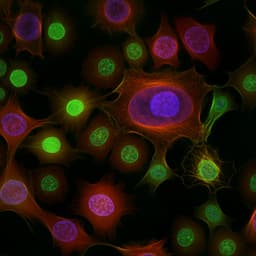
Earth Sciences
Extreme rainstorms drive exceptional organic carbon export from forested humid-tropical rivers in Puerto Rico
K. E. Clark, R. F. Stallard, et al.
Research conducted by K. E. Clark and colleagues reveals that extreme rainfall in the Luquillo Mountains of Puerto Rico plays a crucial role in exporting significant amounts of particulate organic carbon. Their findings highlight the unique contribution of these catchments to the carbon cycle, as they serve as substantial sinks for atmospheric carbon dioxide through the export of biogenic materials during heavy rainstorms.
Playback language: English
Introduction
Rivers play a crucial role in the global carbon cycle, acting as either net atmospheric carbon sinks or sources depending on factors like bedrock composition, weathering rates, and rainfall patterns. Catchments with carbon-poor bedrock typically act as sinks, while those with abundant petrogenic organic carbon or sulfides are sources. Understanding river carbon budgets across diverse geological settings is vital for accurate global carbon cycle assessments. Biogenic organic carbon (OC) erosion is a significant component of this cycle, with each catchment possessing a unique carbon budget influenced by various sources and sinks. Igneous montane islands, like Guadeloupe and Hawaii, primarily function as carbon sinks due to the burial of river particulate organic carbon (POC) in ocean sediments and the production of dissolved inorganic carbon (DIC) during silicate weathering. Conversely, petrogenic organic carbon and sulfides in bedrock release CO2 upon oxidation. While humid-tropical igneous montane islands and continental landscapes with island-arc geology represent significant potential carbon sinks through biogenic POC erosion, their carbon budgets remain poorly understood. River biogenic POC transport is strongly linked to suspended sediment (SS) transport, typically following a coupled exponential relationship. Global biogenic POC fluxes are often estimated using regressions based on river SS yields, leading to an estimated annual biogenic OC erosion of 110–230 MtC. However, most rivers in these global compilations drain sedimentary rocks rich in petrogenic carbon, potentially skewing these estimates. At the watershed scale, carbon transport is influenced by both physical and chemical erosion. Annual dissolved carbon (DOC and DIC) yields tend to increase linearly with discharge, whereas POC export displays a non-linear relationship, with a significant portion (up to 75%) exported during periods of high discharge. Extreme rainfall events, projected to become more frequent and intense in the tropics, play a disproportionate role in sediment and POC export but are under-represented in in situ river studies. In rivers with high SS yields directly discharging into the ocean, a substantial portion (over 65%) of river biogenic POC may be buried in offshore sediments. Estimating river biogenic POC export as a percentage of net primary productivity (NPP – NPP<sub>export</sub>) provides a useful metric for assessing ecosystem impact. However, in tropical regions, simultaneous quantification of landscape NPP and river POC fluxes remains rare. This study investigates river SS and carbon fluxes (biogenic POC, DOC, DIC) during large to extreme rainfall events in humid-tropical, naturally vegetated catchments in eastern Puerto Rico, focusing on regions with low petrogenic carbon and sulfides in the bedrock. The study aims to assess SS and carbon yields, estimate biogenic POC burial in the nearby ocean, evaluate carbon transfer within the geological carbon cycle, determine the percentage of NPP exported as POC, and analyze river carbon fluxes during extreme rainfall events. Finally, it compares SS and biogenic POC relationships in these rivers to global patterns.
Literature Review
The study builds upon previous research highlighting the importance of rivers in the geological carbon cycle, particularly the contrasting roles of catchments with carbon-rich and carbon-poor bedrock. Existing global estimates of biogenic POC export rely heavily on relationships between POC and suspended sediment yields, but these relationships are often derived from catchments with easily erodible sedimentary rocks and high petrogenic carbon content. The authors acknowledge the underestimation of biogenic POC in rivers with low SS yields but high biogenic POC production, as seen in previous studies in regions like Guadeloupe and Hawaii. The non-linear relationship between POC export and high discharge events has been previously documented, emphasizing the importance of extreme events in carbon cycling. However, the scarcity of in-situ measurements during these extreme events has limited our understanding. The study draws upon past research in the Luquillo Mountains, which provides a rich dataset on hydrological and biogeochemical processes, offering a unique opportunity to study the influence of extreme rainfall events on carbon export.
Methodology
The study focuses on two rivers in the Luquillo Mountains of Puerto Rico: Icacos and Mameyes. These catchments, with granodioritic and volcaniclastic bedrocks respectively, lack significant petrogenic organic carbon, reduced sulfur, or carbonates. They are characterized by high rainfall and runoff. The data utilized encompasses over 4000 river samples collected over 25 years (1991-2015), spanning a wide range of SS and POC concentrations and runoff rates. Continuous river discharge data from the U.S. Geological Survey (USGS) were integrated with river constituent concentration data. The USGS program LOADEST was used to determine river yields. Biogenic POC yields were calculated, and these values were compared to previously published estimates, which were adjusted based on improved methodologies. The study used two methods to determine carbon content: elemental analysis and coulometry. The global average of 22 ± 5% was used to estimate biogenic POC burial efficiency in the absence of direct measurements in the adjacent ocean. To further understand the carbon budget, the study incorporated DIC production from silicate weathering. Global river relationships between biogenic POC yield and SS yield, as well as NPP<sub>export</sub> and SS yield, were analyzed for both petrogenic-carbon-poor and petrogenic-carbon-rich rivers. The study used log-log transformations and regression analysis to model these relationships. Rainfall events were categorized into three groups based on rainfall amounts (<22 mm, 22-92 mm, and >92 mm). River fluxes were extracted for each category to determine the contribution of different rainfall events to the annual carbon export. Finally, NPP<sub>export</sub> was calculated to assess the proportion of NPP exported as POC and DOC.
Key Findings
The study reveals significantly higher biogenic POC yields than previously reported for the Icacos (65 ± 16 tC km⁻² yr⁻¹) and Mameyes (17.7 ± 5.1 tC km⁻² yr⁻¹) rivers. These higher yields result from improved sampling methodologies, which included data from extreme rainfall events that were previously underrepresented. The biogenic POC yields from Icacos and Mameyes are comparable to yields from other montane rivers globally. The Icacos exhibited exceptionally high yields (97 to 179 tC km⁻² yr⁻¹) during years with frequent tropical storms. The estimated biogenic POC burial (POC<sub>burial</sub>) was 14.3<sup>+7.7</sup><sub>-6.0</sub> tC km⁻² yr⁻¹ for Icacos and 3.9 ± 1 tC km⁻² yr⁻¹ for Mameyes. The estimated atmospheric CO2 sink (carbon budget) was substantial and negative for both rivers (-25.3 ± 3 and -17.3 ± 1 tC km⁻² yr⁻¹ for Icacos and Mameyes, respectively), primarily due to POC<sub>burial</sub> and DIC production from silicate weathering. Existing global regressions based on SS yield significantly underestimate biogenic POC yields in these rivers (by 92 ± 2% and 87 ± 3% for Icacos and Mameyes, respectively). The study proposes separate regressions for rivers draining petrogenic-carbon-poor (<2% petrogenic OC of total POC) and petrogenic-carbon-rich bedrock. The study reveals a strong influence of extreme rainfall events on carbon export, with these events contributing disproportionately to the annual SS and biogenic POC yields (54–63% and 52–60%, respectively). In contrast, DIC export was dominated by smaller rainfall events. The biogenic POC:DOC ratio was higher in Icacos (5.0 ± 1.0) than in Mameyes (2.0 ± 0.2), highlighting the dominance of particulate organic carbon in Icacos's river export. The NPP<sub>export</sub> as biogenic POC was also significantly higher for Icacos (6.6 ± 1.6%) compared to Mameyes (1.7 ± 0.7%). The study also introduced new regressions for NPP<sub>export</sub> for petrogenic-carbon-poor and rich rivers.
Discussion
This research demonstrates the significant role of extreme rainfall events in driving exceptionally high biogenic POC export from humid-tropical rivers draining petrogenic-carbon-poor bedrock. The substantial underestimation of biogenic POC yields by existing global models highlights the need for separate accounting of rivers draining these types of bedrock. The findings underscore the importance of including data from extreme events when assessing carbon budgets, as these events contribute disproportionately to overall export. The observed differences in biogenic POC:DOC ratios between the two study rivers suggest distinct mechanisms governing organic carbon transport. The high NPP<sub>export</sub> values, especially for the Icacos River, imply rapid erosion rates exceeding soil development rates. The new regression models proposed for petrogenic-carbon-poor rivers may significantly improve estimates of biogenic POC export in similar environments globally, potentially leading to a significant upward revision of global biogenic OC export estimates. This study strengthens the understanding of carbon cycling in humid tropical regions and the influence of climate change on these processes.
Conclusion
This study significantly advances our understanding of carbon export dynamics in humid-tropical rivers, particularly those draining petrogenic-carbon-poor bedrock. The findings reveal the crucial role of extreme rainfall events in shaping carbon fluxes and highlight the limitations of existing global models in accurately predicting biogenic POC yields in such systems. The proposed separate regressions provide a more robust approach for estimating carbon export from these environments. Future research should focus on expanding in-situ measurements during extreme events across a broader range of tropical catchments and improving our understanding of POC burial efficiency in coastal marine environments. This enhanced understanding is essential for improving global carbon cycle models and projecting the effects of climate change on tropical riverine carbon dynamics.
Limitations
The study is limited by the lack of direct measurements of biogenic POC burial in the coastal ocean adjacent to the study area. Estimates of POC<sub>burial</sub> rely on a global average burial efficiency, which may not perfectly represent conditions in the specific study area. The analysis of rainfall events was based on a single rain gauge located in the Icacos catchment, potentially introducing some uncertainty in the timing and quantification of rainfall events for the Mameyes catchment. The temporal coverage of the dataset (1991-2015) does not include some of the largest recorded hurricanes in the region, which might have resulted in even higher carbon export rates. Finally, the generalization of the proposed new regression models requires further validation through studies in other petrogenic-carbon-poor catchments.
Related Publications
Explore these studies to deepen your understanding of the subject.







